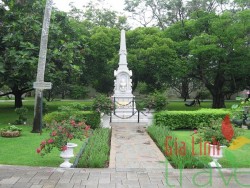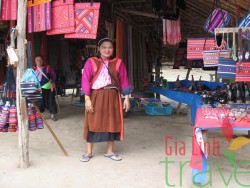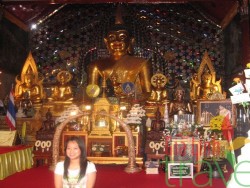Ayutthaya
Thailand Traditions and culture
Chiang Mai Thai Temple Thailand is a country of scenic diversity and ancient traditions, of tranquil temples and modern urban excitement. With and independent history going back more than seven centuries, it has managed to absorb a variety of cultural influences and blend them into something uniquely and memorably Thai. Each of its four major regions offers a distinctive experience for the traveler in search of discovery. Misty mountains in the north shelter verdant valleys and exotic hill tribes, while in centers like Chiang Mai traditional customs and crafts have been preserved over generations. Along the picturesque coastlines of the east and south lie some of the world’s most beautiful beaches and off-shore islands, each with its own beauty. Scattered over the northeastern plateau are superb khamer monuments from the time of Angkor Wat and natural parks teeming with wild life. In the Central Region the evocative ruins of ancient Thai capitals and bustling Bangkok with its dynamic and countless pleasures can be found. CENTRAL REGION The fertile Central Plains region, watered by the winding Chao Phraya River, has long been Thailand’s cultural and economic heart. “Kin khao”, the Thai expression for “to eat”, translates literally as “to eat rice”; and the vast checkerboard of paddy fields on either side of the river has traditionally provided the kingdom with its staple grain. When the annual monsoon rains sweep across the plains, the fields are transformed into a sea of vivid green dotted here and there with farming villages and the occasional gleaming spire of a Buddhist temple. In the early 13th century, the first independent Thai capital was born at Sukhothai, thus ushering in a Golden Age of Buddhist art and architecture; the impressive remains of Sukhothai have been preserved as part of a historical park, a major attraction for visitors to the region. Bangkok became the capital in 1782 with the founding of the Chakri Dynasty that still occupies the Thai throne. Its early rulers sought to recreate the glories of Ayutthaya and many of the city’s landmarks date from this period, among them the magnificent Grand Palace and its adjacent Wat Phra Keo (Temple of the Emerald Buddha),Wat Arun (Temple of Dawn), and Wat Pho (Temple of the Reclining Buddha). The flavor of the capital’s past can be captured by a boat ride along the Chao Phraya River that flows through its traditional heart or an exploration of the picturesque klongs, or canals of Thonburi. The city quickly outgrew its original walled center and is today a huge metropolis of high-rise buildings, air-conditioned shopping centers, and world-class luxury hotels. Despite its Western facade, however, Bangkok remains distinctively Thai, a fusion of modern and traditional, full of fascinating things to discover. All of Thailand’s legendary bargains lustrous silks, bronze ware, antiques, gemstones, and jewelry, to mention only a few are available here, along with countless fine restaurants and other places dedicated to the pursuit of what Thais call sanuk, or pleasure. Easily accessible to Bangkok are other attractions, among them the world’s largest Buddhist monument at Nakhon Pathom, the famous Bridge over the River Kwai built during World War II, and, on the east coast of the Gulf of Thailand, the lively seaside resort of Pattaya Much of what we now know as Thai cuisine also evolved in the Central Region. Rice, fish, and vegetables, flavored with garlic, black pepper, and nam pla, or fish sauce, along with an abundance of fresh fruits, comprised the basic diet of Sukhothai. With the rise of Ayutthaya, other elements were added to the increasingly complex Thai blend. That now essential ingredient, the fiery-hot chili pepper, was introduced at this time, along with the equally popular coriander, lime, and tomato. These may have been brought from their native South America by the Portuguese, who opened relations with Ayutthaya in 1511 and also left a lasting imprint in the form of popular Thai sweets based on egg yolks and sugar. Other influences came from India, Japan, Persia, and especially, China, though in almost every case their contributions were subtly altered and transformed to suite Thai tastes. Unlike the north and northeast, where glutinous rice is popular, Central Thais like the fragrant plain variety, most commonly steamed but sometimes fried or boiled. In addition to fresh-water fish, there is seafood from the nearby gulf as well as a wide range of fresh vegetables and such fruits as mangos, durians, custard apples, guavas, and pomeloes. Sino-Thai food is popular in cities like Bangkok, particularly in the form of numerous noodle dishes. THE NORTH Until the early years of the present century, northern Thailand was effectively isolated from the rest of the country, a region of wild, densely forested mountains where elephants worked in the teak industry along the Burmese and Laotian borders and old temple-filled town like Chiang Mai, founded in 1297, that were part of the ancient Lanna Thai Kingdom. The first railway linking Chiang Mai with Bangkok only opened in 1921, and good roads did not come until several decades later. This long isolation helps explain many of the characteristics that make the north so appealing to visitors today : a sense of traditions not merely preserved but vitally alive, gentle customs that reveal themselves in countless ways, distinctive differences of scenery, architecture, language and food. Tourists can explore the charms of Chiang Mai, where life moves at a different pace from Bangkok, ornate temples rise on almost every street, and the shops are filled with handicrafts native to the region and still made by traditional methods handed down over generations. There are woodcarvers who produce and endless variety of decorative figures, panels, and furniture, as well as other artisans who create fine lacquer bowls, silverware, homespun cotton and silk, delicate embroidery, and hand-painted umbrellas. All these crafts, along with many others, can be found at the famous Night Bazaar in the center of town. Chiang Mai is also noted for its frequent festivals such as the Winter Fair at the end of December, the Flower Festival in February, Songkran (the old Thai New Year) in April, and Loy Krathong in November. Most regular activities cease during these gala events, which attract people from all over Thailand as well as from abroad. Other notable northern towns include Lamphun, once known as Haripunchai and founded by Mons in the 7th century; Lampang, where picturesque horse-drawn carriages still ply the streets; Mae Hong Sorn, nestled in a secret valley of exceptional beauty; Chiang Rai, a popular base for treks into the hills; and Chiang Saen, at the tip of the so-called “Golden Triangle” where Thailand’s borders meet those of Laos and Myanmar. Lovers of adventure can take an elephant ride through the jungle or watch the great animals being trained at one of several camps, go for a boat ride along the scenic Kok River from Chiang Rai, climb Doi Inthanon, the highest mountain in Thailand which is now surrounded by a national park, or go on treks to remote hill tribe villages. There are seven principal tribal groups and they are among the most exotic attractions of the far north, each with its own special culture and spectacular costumes that include a profusion of silver jewelry and magnificent embroidery. The food of the north is as distinctive as its culture. Instead of the soft rice of the central region, a steamed glutinous variety is preferred, traditionally kneaded into small balls with the fingers and used to scoop up more liquid dishes. Northern curries are generally milder than those of central and northeastern Thailand. The influence of neighboring Myanmar is evident in such popular dishes as gaeng hang lay,a pork curry that relies on ginger, tamarind, and turmeric for its flavor, and khao soil, a curry broth with egg noodles and meat, topped with spring onions, pickled onions, and slices of lime. A favorite regional specialty is a spicy pork sausage called naem, eaten in a variety of ways and probably the delicacy northerners miss most when the move to another part of the country. The traditional form of meal in the north, especially when guests are being entertained, is called a khantoke dinner khan meaning bowl and toke a low round table. Diners sit on the floor around the table and help themselves to assorted dishes which, besides glutinous rice, may include one or two local curries, a minced-meat dish seasoned with chillies, a salad, fried pork rind, and various sauces and condiments. If it is in season, dessert is likely to be lamyai, or longan, a delicious Iycheelike fruit for which the north is famous. THE NORTH EAST Of all the region of Thailand, the northeast is perhaps the least known among foreign visitors, in spite of the fact that it covers almost a third of the country’s total area and includes the second largest Thai city, Khon Kaen. This neglect is changing, however, more and more tourists are beginning to discover the northeast’s many unique attractions, both natural and historical. In the 1960s, near the small village of Ban Chiang in Udon Thani province, one of the most exciting chapters in modern archeology began with the accidental discovery of a prehistoric burial site. Subsequent exploration revealed a culture going back to nearly 4,000 B.C. and numbering among its achievements the use of sophisticated bronze metallurgy as well as rice cultivation and beautiful painted pottery. Some of the remarkable Ban Chiang finds are displayed in a museum near the site, and one of the excavations has been preserved to show its different levels. In historical times, between the 9th and 14th centuries A.D., the northeast was part of the great Khmer empire ruled from Angkor, and as a result it contains some of the finest classical Khmer ruins to be seen outside of Cambodia itself. Among the most beautiful is Prasat Hin Phimai, near the provincial capital of Nakhon Ratchasima, which was once linked by a direct road to Angkor, and Phanom Ruang in Buriram province, recently restored by the Fine Arts Department. In all, there are more than 30 Khmer ruins scattered about the region, all of unusual architectural interest. Besides such archaeological sites, the northeast also has a number of spacious national parks and wildlife preserves sure to be on interest to any nature lover. The best known, because of its easy accessibility to Bangkok, is Khao Yai, which covers more than 2,000 square kilometers of forest, grassland, and rolling hills in four provinces and provides shelter for some 200 species of I wildlife, including elephants, tigers, deer, and a wide selection of birds. Phu Kadung, in Loei province, is centered on a mountain topped by a 60_square-kilometer plateau of exceptional natural beauty, while the Phu Khieo Wildlife Preservation Zone in Chaiyaphum province is a royally-initiated sanctuary for a variety of endangered I species. The great Mekong River that forms the border between Thailand and Laos is another notable scenic attraction. One of the northeast’s greatest assets is its hospitable people, who make visitors feel welcome at several memorable festivals during the year. The Elephant Roundup, held every November in Surin province, brings together nearly two hundred of the animals to take part in a display of their skills, with special trains bringing guests from Bangkok for the events. Rocket Festivals, or Boon Bang Fais, are held in a number of provinces, the most famous being in Yasothon in May; enormous home-made rockets are fired at the peak of the lively celebration in the hope of ensuring a plentiful supply of rain for the coming crop. The beautiful Candle Festival, which marks the start of Buddhist Lent in July, attracts people from all over the country to Ubon Ratchathani, where huge, imaginative candles are paraded through the streets of the provincial capital. Northeastern food reflects the influence of neighboring Laos in a number of dishes. As in Laos (and also northern Thailand) glutinous rice is the staple, eaten both as a base for other dishes or as a sweet when steamed in a piece of bamboo with coconut milk and black beans; and such Laotian herbs as dill (called pak chee Lao, or Lao coriander in Thai) turn up as seasoning. A popular regional dish of Lao origin is khanom buang, a thin crispy egg crepe stuffed with shrimp, bean sprouts, and other ingredients. Northeasterners like their food highly seasoned, and regional specialties like laab, made with spicy minced meat or chicken, som tam (green papaya salad), and gal yang. (bar B-Q Chicken) Meat is often scarce in villages and freshwater fish and shrimp are the principal source of protein, sometimes cooked with herbs and spices and sometimes fermented. Thanks to the large numbers of north-eastern who have come to work in Bangkok, food of the region is widely available in the capital. THE SOUTH Southern Thailand consists of a long peninsula, reaching all the way down to Malaysia. Rugged limestone mountains, covered with lush jungle, rise along its spine, while its two coastlines– 1,875 kilometers long on the Gulf of Thailand and 740 kilometers on the Indian Ocean shelter countless beaches of exceptional pristine beauty along with prosperous fishing ports. Besides its rare natural beauty, the south also has vast plantations of rubber, coconut, and pineapple and near the Malaysian border, a distinctive cultural difference thanks to a largely Muslim population. Hua Hin, on the western coast of the gulf, became Thailand’s first popular seaside resort in the 1920s when the southern railway line made it easily accessible to Bangkok. King Rama VII built a summer palace there, called Klai Kangwon, “Far From Worries”, and other aristocratic families acquired property along the scenic beach. Now the resort can boast a number of modern hotels and has spread to include nearby Cha-am, but it still has a quieter, more restful ambiance than vibrant Pattaya across the gulf. Modern travelers further south, where they have discovered other exciting destinations. The most celebrated is Phuket, a large island in the Andaman Sea, was widely known among ancient traders for such natural wealth as tin ore and edible birds nests harvested from limestone caves and cliff sides. Phuket today, just an hour’s flight from Bangkok, is famous for a string of picture – postcard beaches on its western coast, each with its own particular charms and a wide range of accommodations Not far from Phuket is Phang Nga Bay, a marine national park, where hundreds of limestone islands rise dramatically from the sea to form a breath taking scenic spectacle, along with the equally beautiful Phi Phi islands, where turquoise waters lap the white sands of a dozen secret coves and daring sea gypsies scale the walls of a vast, cathedral-like cave to collect the birds’ nests so prized by Chinese gourmets throughout the world. More adventurous travelers in search of unspoiled natural beauty and diving thrills can explore the Similan Islands in the Andaman Sea, a group of nine small islands off which lie countless dazzling coral reefs, or, southward near Malaysia, the huge Tarutao National Park, where 51 islands cover an area of nearly 1,500 square kilometers. Across the peninsula, off the southeast coast, lies the island of Koh Samui, a more recent tourist discovery that also offers memorable beaches fringed by graceful coconut palms and a number of smaller off-shore islands. Several southern cities such as Nakhon Si Thammarat, Chaiya, and Songkhla can look back on an ancient history, reflected in deep-seated traditions, the remains of splendid temples, and elegant old houses. Others like Hat Yai, Thailand’s third largest provincial capital, have a booming modern energy fueled by the region’s prosperity, attracting large numbers of Malaysian tourists with shops and entertainment facilities. In the southernmost provinces of Narathiwat, Pattani, Yala, and Satun, the domed mosque is as much a part of the landscape as the spires of a Buddhist temple, and Malay is the second language of most people. Southern food is as distinctive as its scenery. Not surprisingly, the coconut, which grows so widely throughout the region, plays a prominent role in many dishes; its milk tempers the heat of chill-laced soups and curries, its oil is often used for flying, and its grated meat serves as a condiment. Also only to be expected is the abundance of fresh seafood from the surrounding waters: marine fish, some of huge size, prawns, rock lobsters, crab, squid, scallops, clams, and mussels. Cashew nuts from local plantations are eaten as appetizers or stir-fried with chicken and dried chillies, while a pungent flat bean called sataw adds an exotic, somewhat bitter flavor much admired by southern diners. Regional fruits include finger-sized bananas, mango-steens, durians, and small, sweet pineapples. Sino-Thai food is popular in most large cities; every year the large Chinese community of Phuket stages a ten-day Vegetarian Festival during October, with colorful parades as well as exotic culinary treats. Other foreign influences can be found in such dishes as gaeng massaman, a mild Indian-style curry seasoned with cardamon, cloves, and cinnamon, several Malayan fish curries, and Satan skewered meat with a spicy peanut sauce that originally came from Indonesia.


When Sukhothai’s power waned, a new capital rose further south on the banks of the Chao Phraya. Known as Ayutthaya, it ruled the kingdom for more than four centuries and became one of the largest, most cosmopolitan cities in Southeast Asia. Traders came not only from China, Japan and other Asian countries but also from distant Europe, bringing with them a wide range of new cultural influences. Ayutthaya was destroyed by an invading enemy in 1767 and today its extensive remains also attract numerous sightseers, many of whom come up from Bangkok by the traditional river route.
